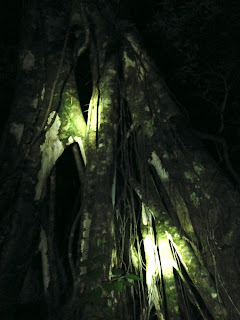We wake up to a bright, healthy breakfast in the Cassowary Cafe.
We suit up in zip harnesses.
We tread the hamster wheel to lift other zip liners up to the first treetop
station in the Daintree forest canopy.
We are on a platform, ready for zipping along steel cables
strung between tall and sturdy trees.
The view from the canopy shows a clear beach and ocean on
this sunny day.
Zipping from station to station, we gain more confidence. The activities become more adventurous. Eitan films his father zip-lining upside down
to the sixth station.
The last lines zip downhill, accelerating Eitan and Mark to 40 kilometers per hour. We come to
screeching halt as a magnetic "zip stop" suddenly engages.
The afternoon brings us to a boat cruise on the Daintree
River, where we meet all sorts of wildlife.
Here is Scarface, the dominant male crocodile in these parts.
We watch two beautiful kites take off from the riverbank, and
fly off into the trees.
Eitan says goodbye to James, our chatty and knowledgeable
tour guide. The tour bus takes two hours
to drive us south along the coast to Cairns, back to civilization.





























